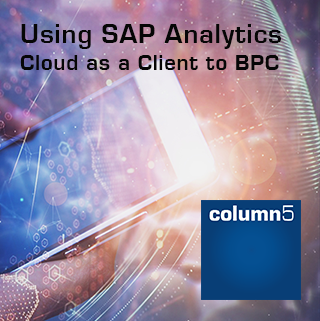For years, SAP Business Planning and Consolidation (BPC) customers have dutifully paid their 20–22% annual maintenance fees—expecting updates, innovation, and support. In 2025, it’s time to ask a hard question: What are you really getting in return?

SAP Analytics
Thought Leadership
BPC Lifeline - What are my BPC Options for BPC End of Support and SAP Maintenance?
Topics: HANA, Analytics, Cloud, BPC, SAP HANA, Analytics Cloud, SaaS, SAC, BPC Lifeline
Using SAP Analytics Cloud as a Client to BPC
SAP Analytics Cloud (SAC) is delivered as a SaaS (Software as a Service) solution on the SAP HANA Cloud Platform. SAC combines multiple EPM, BI and Analytics features/benefits into one product. This allows users to plan with robust collaboration features while using Predictive Analytics as well as Business Intelligence, and robust, state of the art Analytics. Currently, SAP BPC remains the default approach for Enterprise-wide Planning, Forecasting and Consolidations, while SAP Analytics Cloud fulfills relatively straightforward requirements from a planning and forecasting perspective.
Topics: HANA, Analytics, Cloud, BPC, SAP HANA, Analytics Cloud, SaaS, SAC
Buying an Adequate Level of Service
Column5 offers many solutions and best practice concepts outlined in numerous blogs and webinars with the intent of supporting clients who wish to cultivate an internal capability to best elicit value from their EPM solutions. While all are recommended for our clients, we understand that for many organizations, being in a confident position to properly support their EPM investment is not easily met immediately after go live. We have found some clients looking for assistance with adhering to these best practices, or a little extra bandwidth to supply additional continued support post go-live. In response to these requests, Column5 has assembled a number of services designed to fill any gaps in your EPM deployment plan.
Topics: Best Practices, Process Improvement, EPM Maturity, Cloud
As an IT professional, I was very interested in HANA when the product first came out to the market two plus years ago. Initially getting started on HAHA involved buying all physical hardware, which put smaller companies on the sidelines due to high start-up cost. Over time, HANA has truly transformed by getting more and more features added with the new service packs. It was not just the features, but also the support expansion that enables you to run HANA on the various vendor’s hardware and the ability to run it on virtualized hardware such as VMWare and AWS (Amazon Web Service). The best part from an IT perspective, is that while it used to take weeks or even months to setup HANA, now you can be up and running in matter of hours if you utilize providers such as AWS.
I have worked with HANA on physical, virtualized, and cloud platforms, and they all offer a wide range of performance and memory levels. HANA can currently be installed as standalone or scale-out (aka multi-server configuration). When it comes to HANA memory size capacity, you can scale up to 6TB of the memory for a single system, and the scale-out cluster can have up to 112TB+. When it comes to cloud offerings, they are not currently available with such a large memory capacity, but their offerings change for the better all the time. In my opinion, the fastest way to test HANA in your own environment would be to utilize virtualized hardware that most organizations already have in place. I know that some shops are mostly Microsoft, and since HANA runs on Linux they are hesitant about having to support a different operating system; but, to put this in perspective, more than 70% of all websites in the world run on some Unix operating system, and that is due to their flexibility and high reliability. Having to support multiple operating systems is inevitable. HANA was initially only offered on SUSE aka SLES (SUSE Linux Enterprise Server), and due to demand it is now also offered on Red Hat Linux. In my opinion, unlike Windows, Linux requires a lot less maintenance.
Topics: HANA, Enterprise Performance Management (EPM), Cloud, BPC (Business Planning & Consolidation)
3 Reasons Why EPM Unwired Will Add Value to Your Organization
The SAP EPM Mobility suite continues to gain momentum, most recently with the addition of Planning and Consolidation (BPC) to the SAP EPM Unwired app. SAP announced a mobile version of BPC in October 2012, and demonstrated the mobile app at SAP Financials 2013 in Las Vegas.
Topics: HANA, Enterprise Performance Management (EPM), Cloud, Value, BPC (Business Planning & Consolidation)
If you’ve read anything which has come from SAP in the last few months you will have heard of HANA. I understood that SAP thought it was very important but didn’t really understand what it was and how it was going to affect me. After some reading, attending a couple of courses and being involved in some discussions with SAP I know a little more and would like to share it with you.
Topics: HANA, Enterprise Performance Management (EPM), Consolidation, Cloud, Roadmap, Value, Data, BPC (Business Planning & Consolidation)
EPM Integration:Financial Information Management -Pt. 2 Configuration
This is Part 2 of 2 dealing with EPM Integration and Financial Information Management. If you have not read Part 1 discussing Installation, please read it first. For me, there are two components to configuration. First there are systematic configurations to bring the environment up and running. And then there is usability configuration to setup user & groups (although it’s part of environment configuration...), but most importantly creating and configuring data store connections.
Topics: Process Improvement, Enterprise Performance Management (EPM), Cloud, Financial Information Management, BPC (Business Planning & Consolidation)
A cloud buster is a device invented by Austrian Wilhelm Reich, who claimed to be able to produce rain by draining energy from the cloud--effectively "busting a cloud." This far-fetched claim reminds me of some of the outlandish claims being made about how revolutionary cloud technology is these days. The fact is, the cloud has its place for some customers, but it is not quite the ultimate enterprise performance management (EPM)solution as it may be billed. The goal of this post is to discuss the realities, pros, and cons of the cloud deployment model that is becoming more popular in the market.
Topics: Thought Leadership, Enterprise Performance Management (EPM), Cloud, Performance, Value, BPC (Business Planning & Consolidation)
Subscribe
Recent Posts
Posts by Topic
- Enterprise Performance Management (EPM) (93)
- BPC (Business Planning & Consolidation) (75)
- Best Practices (51)
- Performance (49)
- Thought Leadership (47)
- Implementation (35)
- Process Improvement (27)
- Training (25)
- Value (25)
- Project Management (19)
- EPM (18)
- Data (16)
- Excel (16)
- BPC (14)
- Roadmap (14)
- sap bpc (14)
- User Experience (12)
- Analytics (11)
- EPM ROI (11)
- Center of Excellence (10)
- Financial Information Management (10)
- Microsoft (10)
- Business Intelligence (BI) (8)
- Cloud (8)
- EPM 10 (8)
- Forecasting (8)
- HANA (8)
- best practices for epm (8)
- Darwin EPM (6)
- Innovation (6)
- NetWeaver (6)
- Technical (6)
- best (6)
- EPM Maturity (5)
- Financial Close (5)
- sap (5)
- BPC11 (4)
- Consolidation (4)
- EPM Add-in (4)
- Executive (4)
- Product Focused (4)
- SO - BPC v10.x (4)
- SO - BPC v11.x (4)
- epm summit (4)
- technology (4)
- xp&a (4)
- Analysis Office (3)
- BPC NW – Embedded (3)
- BPC logic (3)
- BPC planning Master Data and Data Structure (3)
- BPCv10 embedded (3)
- Case Study (3)
- EPM Roadmap (3)
- OutlookSoft (3)
- SAC (3)
- group reporting (3)
- reporting (3)
- API (2)
- Analytics Cloud (2)
- BPC 11, Version for BW/4HANA (2)
- DarCE (2)
- EPM Landscape (2)
- Epm Academy (2)
- Extended Planning & Analysis (xP&A) (2)
- FUTURE OF SAP BPC (2)
- Functional (2)
- Performance Tuning (2)
- SAP Analytics Cloud (2)
- SAP HANA (2)
- SO - BPC v7.x (2)
- SO - Functional Track (2)
- SaaS (2)
- Services Focused (2)
- Upgrade (2)
- analytics tune up (2)
- tuneup (2)
- #EPMInnovation (1)
- AISuccess (1)
- Analysis plug-in v2.7 for Office (1)
- BFC (1)
- BPC Alternatives (1)
- BPC Lifeline (1)
- BPC PLUG-INS (1)
- BPC v10 upgrade (1)
- BW (1)
- CPM (1)
- Capital planning (1)
- EPM & Analysis plug-ins (1)
- EPM Investment (1)
- EPM events (1)
- Embedded (1)
- Extended Support for SAP BPC (1)
- Investment Comparisons (1)
- Rapid Deployment Systems (1)
- SAP BFC Migration (1)
- SAP BPC Technical Issues (1)
- SAP EPM Add-in Crashing (1)
- SAP EPM Add-in Performance (1)
- SO - Executive Track (1)
- SO - Platform - Microsoft (1)
- SO - Technical Track (1)
- VB (1)
- webcast (1)
3 S T E P S
To Enhance Your EPM Performance:
1.Get Your Ultimate Guide to Improving SAP EPM Performance
Learn what could be contributing to your poor performance and how to diagnose common problems. Get tips that will empower you and your team to improve the performance of your system in order to get the most out of your SAP EPM Investment.
2. Test Your BPC Performance
Get a BPC performance report card and custom report to identify performance issues you may not even know you have.
3. Get Your EPM Assessment
Our assessment delivers a complete, best practice roadmap for you to follow. We’ll work together to assess what you need to pivot your financial forecasting, planning, reporting and analysis to handle the compressed requirements from the volatile COVID-19 environment.
















